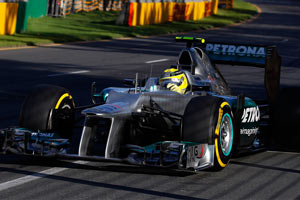
1.) Mercedes' "Double DRS" system uses channels in the body to route air from the rear wing to the car's nose. When the car's DRS system is activated, the flap's motion exposes holes in the rear wing's endplates. Air enters these holes and is then routed forward to the front wing, where it exits on the bottom side to stall the wing, decrease front downforce and boost top speed.
2.) The forward barge board acts solely as a vortex generator. "The rotational direction of that vortex will be counterclockwise," Wirth says, "and because the vortex is traveling downward, it sends down-wash approaching the underbody, which is very favorable. It essentially generates more downforce."
3.) The ornate, sculpted sidepod turning vanes play a vital role in routing the dirty, turbulent wake of air coming off the front tires. "They delay how long it takes before that front-wheel wake starts disappearing under the floor and taking downforce away," Wirth says.
4.)The reference plane, the bottom-most section of the chassis, must be 300–500 mm wide. It creates airflow channels capped and fed by the interior barge boards.
5.) Known as the reference plank, this chamfered skidplate is made from a resin-infused, wood-based composite called Jabroc. It's replaced between track sessions. The holes in the plank's surface allow technical inspectors to measure its thickness, ensuring it stays within the mandated 10-mm (plus or minus one millimeter) tolerance. "The leading edge of the floor will be generating vortices that will then spin down underneath the floor, along the edge of the reference plane," says Wirth. "All of that vortical action reduces the total pressure under the floor and gives you more downforce."
6.)Barge boards produce vortices and increase downforce. "They're cambered like a wing," Wirth says. "Any reduction in pressure there basically torques the floor and reduces pressure all underneath the car."
7.) The car's keel gently moves the column of incoming air underneath the monocoque sideways and out of the way. "It's shaped very carefully and [designed with] the barge boards to generate higher airspeed and thus low pressure."
8.) This small wing sits in what's known as the squish vortex zone. "You have a seal between the rotating tire and the ground," Wirth says, "and the air that hits the tire can't get underneath it, so it forms two very strange jets-they come out at an almost-45-degree angle on each side. This wing is inverted...it has nothing to do with generating lift."
9.) Aperture for the front laser ride-height sensor. It can be set to sample ride height as often as 1000 times per second.
10.) Carbon-fiber front A-arms, with key sections rotated to match the airflow off the front wings and minimize turbulence and drag. Every time the front wing is modified during the season, the car gets a new set of A-arms with a revised, matching angle of twist.
11.) Carbon-fiber backing-plate extensions clean up air coming off the inside of the tire, aiding brake cooling and airflow.
12.) Aluminum tape, 0.05-mm thick. Durable, thin, seals holes and keeps airflow disturbance to a minimum.
Source:
http://jalopnik.com/5952568/explore-the ... car?tag=f1




